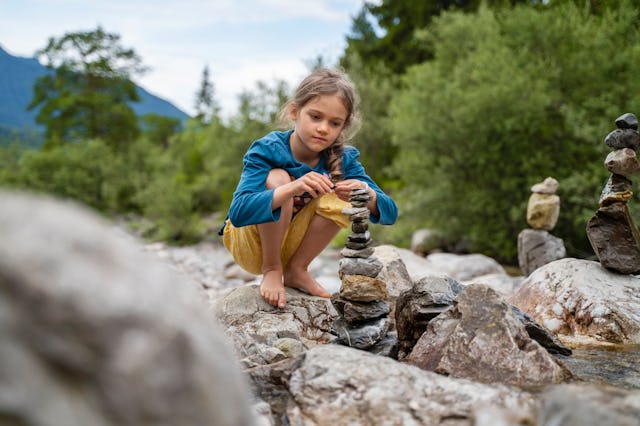Why You Should Think Twice Before Letting Your Kid Stack Rocks On A Hike This Summer
Before your kid builds a mini rock tower on the trail, here’s some food for thought.

It’s only natural for little ones to want to explore every curiosity they come across on the trail — and no secret that kids love to stack anything they can get their hands on. Seems harmless enough, right? Not quite.
At first glance, allowing your kids to make stacked stones while hiking as a family may seem like a fun outdoor activity. However, encouraging your little ones to stack or move rocks outdoors may have severe ecological impacts. When your child pulls stones from the ground, they’re unknowingly damaging habitats and disrupting ecosystems.
It’s not just kids doing the disrupting, either. Adults like to stack rocks as a meditation practice or to challenge their ability to make the impossible possible by balancing them just right so the tower of stones doesn't collapse. But before you do, it’s worth considering the ripple effect: Stacking rocks can harm ecosystems, endanger hikers, disturb wildlife, and disrespect cultural heritage.
You know how the saying goes, though: When we know better, we do better. In that spirit, let’s take a closer look at why this behavior shouldn’t make your summer activity agenda.
Moving rocks disturbs fragile wildlife habitats.
These stone piles are known as cairns — from the Gaelic word meaning "heap of stones." Building them can erode soil and disrupt fragile habitats, especially when the ground beneath is exposed. "Every time we move a rock, we are disrupting the environment by displacing established biology and expediting change that plants and animals must then exert energy to adapt to," Travis Puglisi of Wandering Mojave Hiking Services says.
Rocks are home to everything from reptiles to insects to tiny microorganisms. When we move rocks, we displace all sorts of tiny creatures — from lizards and insects to aquatic life — and upend the delicate balance of their environment. In rivers and streams, moving rocks may alter the ecosystem for aquatic creatures and negatively impact their food sources. Much like collecting seashells is a hazardous hobby for marine life, disturbing rocks can destroy animals' homes.
Bottom line: Stacking rocks isn't planet-friendly and goes directly against leave-no-trace principles.
Park rangers use stone cairns to mark hiking trails to prevent people from getting lost.
"Rocks mark sacred sites, trails, safe routes through boulder-clogged canyons, and campsites. These cairns communicate messages between people and time," Puglisi says. "Such stone markers point hikers in the right direction, particularly ones that serve as guiding signals on challenging terrain. When people make their own rock stacks, the original meaning of the stone marker is lost. In remote areas, this can lead to loss of life."
When there are numerous rock stacks, it endangers others who rely on the genuine cairns should they lose track of the trail. Rock stacks left behind by civilians might lead hikers off established trails and into hazardous areas. Avoid adding rocks to existing stacks, as it may make them unstable and topple.
It hinders others' experience of the great outdoors by disrupting the undisturbed natural beauty.
“When we clutter an environment with non-functional rock stacks, we devalue intentional imagery,” Puglisi says. “Making rock stacks for fun produces visual pollution that devalues other intentionally placed rocks.”
In some parks, stacking rocks isn’t just discouraged — it’s illegal.
Cairns may be considered vandalism or desecration of natural or cultural sites. Rock-stacking in many U.S. National Parks is punishable under legislation that protects the wilderness against vandalism and littering.
Cairns aren’t for us, and that’s OK.
For some cultures, rock stacking is sacred. In these communities, it’s a deeply rooted tradition that deserves respect. Environmental activism shouldn't target Indigenous communities that have a spiritual tradition of rock stacking; Buddhists, who have a storied history of using this practice to balance energy; or Jewish people, who leave rocks on tombs to honor the deceased.
But for the rest of us, there are plenty of more appropriate and less harmful ways to help our kids engage in nature this summer. Challenge your kid to find various colors, shapes, and textures in nature; look for animal tracks; or try to identify bird calls — all hands-off yet still engaging activities that teach children to respect and honor nature.